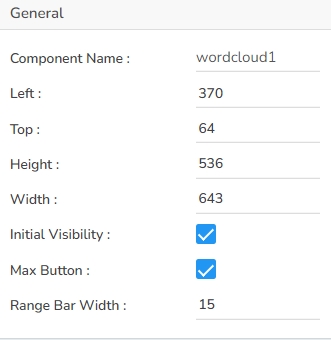Word Cloud
Check out the walk-through on how to use the Word Cloud chart component in the Designer module.

Word Cloud is a visual representation of text data where the font size of a word depicts the frequency of this word in a set of text data. Even though Word clouds are not a perfect tool for data analysis and business data visualizations, they have their place in infographics. Word clouds can also reveal patterns in your responses that may guide future analysis.
Best Situations to Use a Word Cloud Chart
To analyze text data
To identify trends and patterns that would otherwise be unclear or difficult to see in a tabular format
Default Chart Image

Properties of the Word Cloud Chart
General
Component Name: The unique identifier for the Wordcloud chart.
Left: The position of the chart from the left edge of the containing element.
Top: The position of the chart from the top edge of the containing element.
Height: The vertical dimension of the chart.
Width: The horizontal dimension of the chart.
Initial Visibility: Whether the chart is visible when initially rendered.
Max Button: Indicates if a button is available to maximize the chart.
Range Bar Width: Specify the width of the range bar.

Tooltip
Show Tool Tip: Enable or disable the display of tooltips on the chart.
Click the Show Tool Tip icon to access the Tool Tip Configuration window.
Select the Default option.
Click the Save option to display Tool Tip in the default display.

Tooltip Font Size: Set the font size of the displayed text within the tooltip.
Precision: Set the number of decimal places shown in the tooltip values.

Word Styles
Text Opacity: Adjust the transparency level of the text in the word cloud.
Font Family: Choose the font style for the words displayed in the word cloud.
Layout Shape: Define the shape or layout structure of the word cloud (e.g., circular, rectangular).
Max Font Size: Set the maximum font size for the largest word in the word cloud.
Min Font Size: Set the minimum font size for the smallest word in the word cloud.
Fill With Random Colors: Enable or disable the option to fill words with random colors.
Highlight Color: Select a color to highlight specific words within the word cloud.
Highlight Font Size: Set the font size for the highlighted words in the word cloud.
Random Colors: Enable to use a random color palette for the words. Click the Random Colors icon.
Range Colors: Define ranges of colors for the words by providing a limit in the word cloud. Click the Range Colors icon.

Background
Gradient Rotation: The angle at which the gradient background is applied to the chart.
Opacity: The transparency level of the chart's background.
Gradient: The type and direction of the gradient fill used in the background.
Click the Gradient icon.
The Background gradient colors window opens.
Click the Add Color option.
Click the Save option.

Border: The style or type of border surrounding the chart.
Border Color: The color of the border surrounding the chart.
Border Radius: The curvature of the chart's corners.
Shadow: Enable the shadow effect on the chart by marking the given checkbox.
Shadow Color: The color of the shadow effect.
Shadow Transparency: Set the transparency level of the shadow effect.

Title
Title Box Color: Choose the background color for the title box.
Show Title Box: Enable or disable the display of the title box on the chart.
Show Title: Enable or disable the display of the title text.
Title Bar Height: Set the height of the title bar.
Description: Add a description text below the title.
Font Color: Select the color of the title text.
Font Size: Specify the size of the title text.
Font Style: Choose a font style from the available choices (e.g., italic or normal).
Font Weight: Set the weight (boldness) of the font. The supported options are Normal, Bold, 300, 600, and 900.
Font Family: Choose the font family for the title text from the given choices.
Align: Align the title text (e.g., left, center, right).
Text Decoration: Apply text decorations (e.g., underline) to the title text.
Show Dataset Description: Enable or disable the dataset description in the title.

Sub Title
Show Sub Title: Enable or disable the display of the sub-title text.
Description: Add a description text below the sub-title.
Font Color: Select the color of the sub-title text.
Font Size: Specify the size of the sub-title text.
Font Style: Choose the font style for the Sub-title (e.g., italic or normal).
Font Weight: Set the weight (boldness) of the font. The supported options are Normal, Bold, 300, 600, and 900.
Font Family: Choose the font family for the sub-title text from the given choices.
Align: Align the sub-title text (e.g., left, center, right).
Text Decoration: Apply text decorations (e.g., underline) to the sub-title text.

Export Options
Enable Context Menu: Activate a right-click context menu for quick access to export options in the preview mode of the chart.
Export Excel: Save the chart data in an Excel file format (.xlsx).
Export CSV: Export the chart data to a CSV file format (.csv).
Export JPEG: Export the chart as a JPEG image (.jpg).
Export PNG: Export the chart as a PNG image (.png).
Export PPT: Export the chart to a PowerPoint presentation (.pptx).
Export PDF: Export the chart as a PDF document (.pdf).
Show Print: Include an option to print the chart directly.
Export Heading: Add a custom heading to the exported file.
Export Sub Heading: Add a custom subheading to the exported file.
Export File Name: Specify the file name for the exported file/dashboard.
Global Export Type: Define the default export format using the drop-down (e.g., Screenshot, Tabular).

Word Cloud chart by changing the Properties

Sample Data
Download the given sample data and map it as mentioned below to plot your Word Cloud chart:
Select the Word column as Rules, Color_Confidence column as Confidence, and Frequency_Lift column as Lift.
Last updated


